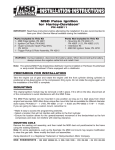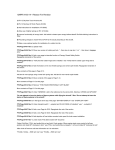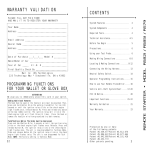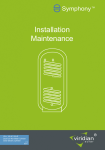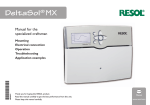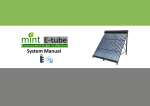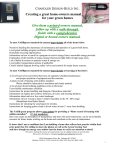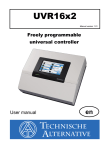Download Pressure Probes - Snap-on
Transcript
Pressure Probes EAK0171L00A (100 psi), EAK0171L10A (500 psi), EAK0171L20A (5000 psi) Table of Contents Safety Information . . . . . . . . . . . . . . . . . . . . . . . . . . . . . . . . . . . . . . . . . . . . . . . . . . . . . . . . . . . . . 1 Introduction . . . . . . . . . . . . . . . . . . . . . . . . . . . . . . . . . . . . . . . . . . . . . . . . . . . . . . . . . . . . . . . . . . 4 Functional Description . . . . . . . . . . . . . . . . . . . . . . . . . . . . . . . . . . . . . . . . . . . . . . . . . . . . . . . . . . 4 Connections . . . . . . . . . . . . . . . . . . . . . . . . . . . . . . . . . . . . . . . . . . . . . . . . . . . . . . . . . . . . . . 5 Test Preparations . . . . . . . . . . . . . . . . . . . . . . . . . . . . . . . . . . . . . . . . . . . . . . . . . . . . . . . . . . . . . 6 Pressure Probe Tests . . . . . . . . . . . . . . . . . . . . . . . . . . . . . . . . . . . . . . . . . . . . . . . . . . . . . . . . . . 6 Before Testing . . . . . . . . . . . . . . . . . . . . . . . . . . . . . . . . . . . . . . . . . . . . . . . . . . . . . . . . . . . . . 7 Cylinder Compression Test . . . . . . . . . . . . . . . . . . . . . . . . . . . . . . . . . . . . . . . . . . . . . . . . . . . 8 Waveform Guidelines . . . . . . . . . . . . . . . . . . . . . . . . . . . . . . . . . . . . . . . . . . . . . . . . . . . . . . 11 Additional Cylinder Pressure Tests . . . . . . . . . . . . . . . . . . . . . . . . . . . . . . . . . . . . . . . . . . . . 13 Engine Oil Pressure Test . . . . . . . . . . . . . . . . . . . . . . . . . . . . . . . . . . . . . . . . . . . . . . . . . . . 16 Transmission Pressure Test . . . . . . . . . . . . . . . . . . . . . . . . . . . . . . . . . . . . . . . . . . . . . . . . . 18 Safety Information IMPORTANT SAFETY INSTRUCTIONS Pressure probes are highly sophisticated test instruments intended for use by properly trained, skilled professional automotive technicians. Safety warnings and cautions in this manual are reminders to operator to exercise extreme care when using this test instrument. There are many variations in procedures, techniques, tools, and parts for servicing vehicles, as well as in the skill of the individual doing the work. Because of the vast number of test applications and variations in the products that can be tested with this instrument, Snap-on cannot possibly anticipate or provide advice or safety messages to cover every situation. It is the automotive technician’s responsibility to be knowledgeable of the system being tested. It is essential to use proper service methods and test procedures and to perform tests in an appropriate and acceptable manner that does not endanger your safety, safety of others in the work area, or vehicle or equipment being tested. It is assumed the operator has a thorough understanding of vehicle systems before using the pressure probes. Understanding of these systems principles and operating theories is necessary for competent, safe and accurate use of this instrument. Use equipment only as described in this manual. PP-1 Pressure Probe Kit Read All Instructions Read, understand and follow all safety messages and instructions in this manual and on the test equipment. Safety messages in this manual contain a signal word with a three-part message and, in some instances, an icon. The signal word indicates level of hazards in a situation. • DANGER indicates an imminently hazardous situation which, if not avoided, will result in death or serious injury to operator or bystanders. • WARNING indicates a potentially hazardous situation which, if not avoided, could result in death or serious injury to operator or bystanders. • CAUTION indicates a potentially hazardous situation which, if not avoided, may result in moderate or minor injury to operator or bystanders. Safety messages in this manual contain three different type styles • Normal type states the hazard. • Bold type states how to avoid the hazard. • Italic type states the possible consequences of not avoiding the hazard. An icon, when present, gives a graphical description of the potential hazard. SAVE THESE INSTRUCTIONS Risk of explosion. • Exceeding the pressure limits of the pressure probes and/or adaptors can cause the equipment to burst. • The pressure probe lead used with pressure probes should not be exposed to temperatures exceeding 250 °F. Explosion can cause injury. Risk of sudden vehicle movement. • Set the gear selector in neutral for a standard transmission or park for an automatic transmission. Set the parking brake. If the vehicle has an automatic parking brake release, disconnect the release mechanism for testing and reconnect when testing is completed. • Disable fuel and ignition systems before testing. Check manufacturer’s service manual for procedures. A moving vehicle can cause injury. PP-2 Pressure Probe Kit Risk of flying particles. • Wear safety goggles, user and bystander. • Do not exceed specified operating psi for any pressure probe. • Be sure all connections are secure. Flying particles can cause eye injury. Risk of entanglement. Keep yourself, clothing and test equipment clear of moving parts. Entanglement in moving parts can cause injury. Be sure that all of the equipment that is being used is approved for the use intended and can handle the pressure involved in the testing sequence. Use only as described in this instruction manual. Use only the manufacturers recommended attachments. Risk of burns. Do not expose the pressure probe lead used with pressure probes to temperatures exceeding 250 °F. Burns can cause injury. • Before each use of this accessory, inspect the connector for bent or missing pins, and inspect the cable for damage. Also, inspect both connectors for foreign objects or dirt, and clean if necessary. • When inserting the connectors, align the keyed detents. Do not use excessive force, and do not rock the connectors back and forth while inserting. • When removing the connectors, grasp the connector housing. Do not pull the cable. • Do not let the cable touch the exhaust manifold. • Flush pressure transducer, hoses and adaptors with gasoline or parts cleaning solvent after use with methanol or methanol blended gasolines. • Periodically check all parts of the pressure probe kit for signs of wear or damage, and replace items when worn. Never use equipment that is showing signs of wear or damage, until it has been examined by a qualified Snap-on service representative. • Pressure transducers, hoses and adaptors should always be flushed with a solvent after any use to prevent the cross contamination of various fluids and systems. (air conditioning, power steering, transmission fluid, brake fluid, fuel, coolant). PP-3 Pressure Probe Kit Introduction Use the Sun pressure probe kits with the Pressure Probe Scope feature to test any vehicle system requiring pressure measurements and to view the pressure measurements over time. There are three Sun pressure probe kits which can be used with any Sun Machine or Counselor II tester. Each kit contains one pressure probe. • 100 psi Pressure Probe Kit, part number EAK0171L100A — The 100 psi kit includes harness EAX0033L00A • 500 psi Pressure Probe Kit, part number EAK0171L10A • 5000 psi Pressure Probe Kit, part number EAK0171L20A Functional Description Figure 1: Pressure Probe and Harness A – Pressure Probes 100 psi, part number 2-16366 500 psi, part number 2-16466 5000 psi, part number 2-16566 B – Pressure Probe Lead Part number EAX0033L00A. Connects from the auxiliary extension lead (not shown) to the pressure probe (A). ✓ PP-4 Included with the 100 psi Pressure Probe Kit only. The pressure probe lead kit may be ordered separately as part number EAK0171L30A for use with the 500 psi and the 5000 psi Pressure Probe Kits. Pressure Probe Kit Pressure Probe Kit 100 psi EAK0171L100A System Possible Tests Fuel – Fuel Injector Drop Tests – Fuel pumps Oil – Sticking pressure relief valves – Anti-Drainback valve Internal Engine – – – – – – – – – – Valve train Compression Fuel system Oil system Exhaust restrictions Piston ring integrity Intake integrity Head gaskets failure Open gasket failure Camshaft timing failure – – – – – – – Restricted filters Clutch and band Internal Solenoid pack Electronic failure Line pressure Worn seals 500 psi EAK0171L10A Transmission/Transaxle Power Steering 5000 psi EAK0171L20A Brakes – Pump and rack – Variable assist – ABS The following sections contain typical examples of some of these tests. • Set the gear selector in neutral for a standard transmission or park for an automatic transmission. Set the parking brake. If the vehicle has an automatic parking brake release, disconnect the release mechanism for testing and reconnect when testing is complete • Read, understand and follow Safety Information in the front of this manual. Connections Use this procedure to connect the pressure probe to the tester and vehicle for all tests in this section. 1. Connect auxiliary extension lead to the TIMING/AUX receptacle on the connection panel. 2. Connect pressure probe lead to the auxiliary extension lead. PP-5 Pressure Probe Kit 3. Connect pressure probe to the pressure probe lead. 4. Calibrate the pressure probe. ✓ For additional information refer to Pressure Probe Calibration. 5. Connect pressure probe to vehicle. 6. Select Scope — Special Patterns — Pressure Probes 7. Setup Scope as necessary for testing. ✓ Pressure probe calibration is required when a different pressure probe is selected or if exit and return to the scope. Calibrate pressure probes at any time by selecting Pressure Probe Calibration from Tools (F4). Test Preparations Tests in this manual assume that: • Tester is on, warmed up and calibrated, • Leads are connected to vehicle in standard configuration, • Vehicle identified using Vehicle ID: — Description, — Quick ID, or — Restore Data. • Vehicle parking brake is applied. • Gear selector is in: — Neutral, if equipped with a manual transmission, or — Park, if equipped with an automatic transmission. • Drive wheels are blocked, • Parking brake is set, and — If vehicle equipped with automatic parking brake release, disable release mechanism. • All testing tips and safety requirements are observed. Pressure Probe Tests Use any of the 0-100, 0-500, and 0-5000 psi pressure probes on any vehicle system requiring pressure measurements. Pressure probes must be calibrated before each use to maintain accuracy. ✓ PP-6 For additional information refer to Pressure Probe Calibration in this manual. Pressure Probe Kit Before Testing Perform pressure probe calibration before testing. ✓ Refer to Safety Information in the front of this manual and testing tips included with each test. Pressure Probe Calibration Pressure probe must be calibrated before each use to maintain accuracy. To perform pressure probe calibration select: — F10 to calibrate the pressure probe connected to the tester. — F9 to use the last good calibration if the pressure probe was recently calibrated and conditions have not changed. ✓ ✓ The scope stores calibration data from the last pressure probe calibrated until you exit the scope or a different pressure probe is selected and calibrated. Select F4 to recalibrate the pressure probe at any time. Select Calibrate Pressure Probe from the Tools menu. To maintain accuracy, recalibrate the pressure probe if subjected to temperature changes during testing. If a pressure probe fails to calibrate, check all probe and cable connections. PP-7 Pressure Probe Kit Cylinder Compression Test Figure 2: Optional Accessories A – Cylinder Test Adaptor Connects from the quick coupler (C) to the vehicle. Not included with kit. B – Brass Adaptor Connects from the pressure probe to the quick coupler (C). Not included with kit. C – Quick Coupler Connects from the brass adaptor (B) to the cylinder test adaptor (A). Not included with kit. D – Auxiliary Extension Adapts the timing auxiliary receptacle for use with pressure probes. Not included with kit. Testing Tips r Starter should be able to maintain adequate cranking speed. r Make sure the cylinder test adaptor does not have a Schrader valve in the end or test results will be invalid. ✓ PP-8 When using the cylinder test adaptor, the Schrader valve must be removed to obtain a valid pressure waveform. Pressure Probe Kit Test 1. Select Setup to set the following scope functions for standard testing: — Signal, Channel 1 - Aux 500 psi — Channel 2, Off — Pattern/Sweep, — 1 sec or 500ms depending on viewing preference and cranking speed of engine — Scale, 250 psi — Trigger, Auto 2. Run vehicle engine to achieve normal operating temperature. • Do not touch hot engine components. • Wear gloves when handling hot engine components. The engine must be at normal operating temperature. A cold engine will give low and inconsistent readings. Complete this test before the engine cools. 3. Disable vehicle ignition system. ✓ For additional information refer to Disabling the Ignition System at the end of this section . 4. Remove vehicle air cleaner. 5. Disable vehicle fuel system. ✓ For additional information refer to Disabling the Fuel System at the end of this section. 6. Remove spark plug. 7. Attach cylinder pressure test adaptor to engine. 8. Attach pressure probe to cylinder pressure test adaptor. 9. Open engine throttle. 10. Crank engine through at least 6 compression cycles. ✓ ✓ Refer to vehicle manufacturer specifications for compression data. For waveform interpretation information refer to Waveform Guidelines on page PP-11. PP-9 Pressure Probe Kit Disabling the Fuel System Relieve fuel system pressure before testing. Refer to the vehicle manufacturer’s procedure for disabling the fuel system. Some common methods of disabling the fuel system follow. Clear Flood Mode – Many newer fuel injected systems can be put into this mode by depressing the accelerator fully to the floor and cranking the engine. This keeps the fuel injectors from activating. Inertia Switch – Most Ford vehicles are equipped with an inertia switch. Lifting the plunger on the top of the switch deactivates the fuel pump. After "tripping" the switch, crank the engine to burn any residual fuel in the fuel rail. Fuel Pump Relay – May be centrally located in the power distribution or maxi-fuse panels, remove this relay to disable the fuel pump. Fuel Injector Fuse(s) – Usually located in the fuse panel, removing this fuse disables the fuel injectors. ECM/PCM Power Fuse(s) – Usually located in the fuse panel, removing this fuse can disable the fuel injectors. Sometimes it disables the fuel and ignition systems. Be sure to check for spark. IMPORTANT: Be aware these fuses may supply "keep alive" memory and removing them may erase learned memory from the PCM. Disabling the Ignition System Refer to the vehicle manufacturer’s procedure for disabling the ignition system. Some common methods of disabling the ignition system follow. External Coils and Coil Wire – Disconnect primary wiring connector from ignition coil. – Remove coil secondary wire from distributor cap and with a jumper wire connect it to a known good ground. Internal Coils – Disconnect primary wiring connector from the distributor or from igniter module. Distrubutorless Ignition – ECM/PCM Power Fuse(s) - Usually located in the fuse panel, these fuses can be removed and the ignition may be disabled. IMPORTANT: Be aware these fuses may supply "keep alive" memory and removing them may erase learned memory from the PCM. – Remove connector at ignition module, igniters or coilpack(s). Ignition Control Relay – Usually located in the power distribution or maxi-fuse panel, this relay can be removed to disable the ignition system. Ignition Control Fuse – Usually located in the power distribution or maxi-fuse panel, this fuse can be removed to disable the ignition system. PP-10 Pressure Probe Kit Waveform Guidelines The cylinder pressure waveform charts the compression cycle of a cylinder. Refer to the normal cylinder pressure waveform, Figure 3 with open throttle. Although minor variances occur depending on the design of the engine being tested, the general characteristics of the "normal" cylinder pressure waveform always remains the same. A low pressure reading at the ready position of the cylinder pressure waveform indicates either a camshaft timing failure or an engine mechanical failure of piston rings, valves, head gasket. ✓ For additional information refer to Piston Ring Integrity Test to diagnose piston ring failure. A high pressure reading at the ready position of the cylinder pressure waveform indicates either a camshaft timing failure or an excessive carbon build-up on the cylinder head. ✓ For additional information refer to Camshaft Timing Failure to diagnose a camshaft timing problem. Figure 3 : Normal Cylinder Pressure Waveform A—Ready Position — — — — Piston has stopped at TDC Cylinder contents are compressed Both valves are closed All is ready for spark ignition B—Power Position — — — — Both valves remain closed Piston has rapidly resumed movement Piston reaches top speed at the halfway point Piston quickly decreases in speed and stop at the end of the stroke C—Vacuum 1 Position — Piston has stopped at BDC — Both valves remain closed — Cylinder pressure has dissipated, and the rapid downstroke of the piston has drawn a vacuum in the cylinder — Exhaust valve is ready to open PP-11 Pressure Probe Kit D—Exhaust Position — Exhaust valve has opened — Piston has rapidly resumed movement — Piston expels cylinder contents through the open exhaust valve — Piston reaches top speed at the halfway point — Piston quickly decreases in speed and stop at the end of the stroke E—Zero Position — Piston has stopped at TDC — Exhaust valve has closed — Intake valve is ready to open F—Intake Position — Intake valve has opened — Piston has rapidly resumed movement — Down-stroke of the piston draws air into the cylinder through the open intake valve — Piston reaches top speed at the halfway point — Piston quickly decreases in speed and stop at the end of the stroke G—Vacuum 2 Position — Intake valve has closed — Piston down-stroke has drawn a slight, non-detectable vacuum in the cylinder. (A closed throttle registers a detectable vacuum.) — Piston has stopped at BDC H—Compression Position — Both valves are closed — Piston has rapidly resumed movement — Cylinder contents are compressed on the piston upstroke — Piston reaches top speed at the halfway point — Piston quickly decreases in speed and stop at the end of the stroke PP-12 Pressure Probe Kit Additional Cylinder Pressure Tests • • • • • • • Piston Ring Integrity Test Intake Integrity Test Exhaust Restriction Intake Restriction Head Gasket Failure Open Valve Failure Camshaft Timing Failure Piston Ring Integrity Test ✓ For waveform interpretation information refer to Waveform Guidelines on page PP-11. 1. Perform Cylinder Compression Test. 2. Save results. 3. Remove pressure probe from cylinder pressure test adaptor. 4. Remove cylinder pressure test adaptor from engine. 5. Squirt a small quantity of oil in open cylinder to seal any existing cylinder wall clearance. 6. Perform Cylinder Compression Test again. 7. Save results. 8. Compare results of the initial test with the results of the second test. Interpretation • No significant change in the ready position of the cylinder pressure waveform indicates piston ring integrity. • A significant increase in the ready position of the cylinder pressure waveform indicates piston ring leakage. Intake Integrity Test ✓ For waveform interpretation information refer to Waveform Guidelines on page PP-11. 1. Perform Cylinder Compression Test. 2. Save results. 3. Close engine throttle or manually block throttle body opening. 4. Perform Cylinder Compression Test with closed throttle. 5. Compare results. PP-13 Pressure Probe Kit Interpretation • Significant change in the intake position of the cylinder pressure waveform indicates intake integrity. • No significant change in the intake position of the cylinder pressure waveform indicates intake leakage. Figure 4: Intake Integrity Test Exhaust Restriction An exhaust restriction can be detected on the cylinder pressure waveform. ✓ For waveform interpretation information refer to Waveform Guidelines on page PP-11. Interpretation • An unrestricted exhaust registers no significant pressure during the exhaust position of the cylinder pressure waveform. A restricted exhaust registers significantly higher pressure. • To diagnose the point of restriction, test adjacent cylinders and/or opposite cylinder bank. Figure 5: Exhaust Restriction Waveform Intake Restriction Performing a cylinder pressure test can detect an intake restriction. ✓ For waveform interpretation information refer to Waveform Guidelines on page PP-11. Interpretation • An unrestricted intake registers no significant vacuum in a "throttle-open" mode during the intake position of the cylinder pressure waveform. • A restricted intake draws a detectable vacuum in a "throttleopen" mode during the intake position of the cylinder pressure waveform. • To diagnose the point of restriction, test adjacent cylinders and/or opposite cylinder bank. PP-14 Pressure Probe Kit Head Gasket Failure To detect head gasket failure on the cylinder pressure waveform, first verify piston ring integrity. ✓ ✓ For additional information refer to Piston Ring Integrity Test. For waveform interpretation information refer to Waveform Guidelines on page PP-11. Interpretation • A failed head gasket is indicated by a loss of pressure during the Compression Position and Vacuum Positions 1 and 2 of the cylinder pressure waveform. • To verify a failed head gasket indication, test adjacent cylinders for similar results. Figure 6 : Head Gasket Failure Open Valve Failure ✓ For waveform interpretation information refer to Waveform Guidelines on page PP-11. 1. To detect open valve failure on the cylinder pressure waveform, first verify piston ring integrity. ✓ For additional information refer to Piston Ring Integrity Test. 2. After piston ring integrity has been verified and the possibility of a head gasket failure has been eliminated, perform Cylinder Compression Test with closed throttle. Interpretation Open valve failure is indicated by a loss of pressure during the Compression Position and Vacuum Positions 1 and 2 of the cylinder pressure waveform. PP-15 Pressure Probe Kit Camshaft Timing Failure ✓ For waveform interpretation information refer to Waveform Guidelines on page PP-11. Timing failure can be detected on the cylinder pressure waveform. Timing failure is indicated by either: • A lower than normal pressure reading at the ready position of the cylinder waveform with higher than normal readings at Vacuum Positions 1 and 2 of the cylinder waveform, or • A higher than normal pressure reading at the ready position of the cylinder waveform with lower than normal readings at Vacuum Positions 1 and 2 of the cylinder waveform. To verify camshaft timing failure, test non-adjacent cylinders or opposite bank cylinders for similar results. Engine Oil Pressure Test The oil pressure waveform shows internal oil pressure fluctuations over a specific period of time and conditions. Figure 7: Normal Oil Pressure Testing Tips r At normal operating temperature, the rise to full stable oil pressure typically takes less than one second. When oil pressure testing is performed on a cold engine, it typically takes longer to register full stable oil pressure. r A cold engine typically has higher than normal oil pressure until the engine reaches normal operating temperature. r Oil pressure typically increases with higher engine RPM and decreases with lower engine RPM. r Over an extended period of running time at constant RPM, engine oil pressure normally drops. Engine oil becomes thinner as the engine temperature increases and allows oil to flow more easily past the engine bearings. Test 1. For — — — — — PP-16 standard testing: Set Signal: Channel 1 - Aux 500 psi Channel 2 - OFF Set Pattern/Sweep: 10 sec Set Scale: 100 psi Set Trigger: Auto Pressure Probe Kit 2. Locate and remove engine oil pressure sending switch. Do not touch hot engine components. Wear gloves when handling hot engine components. 3. Attach oil pressure test adaptor to oil pressure sending switch port on engine. 4. Attach pressure probe to oil pressure test adaptor. When installing the pressure probe into the appropriate adaptor, use care to not overtighten the pressure probe. 5. Start engine. 6. Run vehicle engine to achieve normal operating temperature. Internal Pressure-Relief Valve Failure (Sticking) The oil pressure waveform rises quickly to point (A). Typically, the oil pressure waveform then drops to point (B) and levels out at point (C). Figure 8: Internal Pressure Relief Valve Failure Filter Anti-Drainback Valve Failure The engine must be at ambient temperature to accurately identify this condition. The oil pressure waveform rises relatively slowly under this condition. The oil pressure waveform will typically "plateau" midway and slowly level off at normal pressure. Figure 9: Filter Anti-Drainback Valve Failure PP-17 Pressure Probe Kit Transmission Pressure Test The automatic transmission/transaxle pressure waveform charts internal automatic transmission/transaxle pressure fluctuations over a specific period of time and conditions. A "normal" automatic transmission/transaxle pressure waveform under high line pressure (low gear / 'D1' or reverse / 'R') is shown below. Although minor variances occur depending on the design of the automatic transmission/transaxle being tested, the general characteristics of the "normal" automatic transmission/transaxle pressure waveform always remains the same. ✓ Pump activity may create harmonics, or jagged line, at full pressure. Figure 10: Normal Automatic Transmission/Transaxle Waveform - High Pressure Testing Tips r Under normal operating conditions, the rise to full stable automatic transmission/transaxle pressure typically takes less then one second. When automatic transmission/ transaxle pressure testing is performed on a cold automatic transmission/transaxle, it typically takes slightly longer to register full stable automatic transmission/transaxle pressure. r A cold automatic transmission/transaxle typically has slightly higher than normal pressure until the automatic transmission/transaxle reaches normal operating temperature. Test 1. For — — — — standard testing: Set Signal Aux: Off / 500 psi Set Pattern/Sweep: 5 sec Set Scale: 250 psi Set Trigger: Auto 2. Locate automatic transmission/transaxle test ports per manufacturer specifications. 3. Attach automatic transmission/transaxle pressure test adaptor to the desired automatic transmission/ transaxle test port. Exceeding the pressure limits of the pressure probes and/or adaptors can cause the equipment to burst. PP-18 Pressure Probe Kit 4. Attach pressure probe to automatic transmission/ transaxle pressure test adaptor. When installing the pressure probe into the appropriate adaptor, do not overtighten the pressure probe. 5. Using appropriate safety equipment, lift vehicle to disengage drive wheels from ground or 6. Apply vehicle parking brake and block appropriate drive wheels according to gear selected for test. Set the gear selector in neutral for a standard transmission or park for an automatic transmission. Set the parking brake. If the vehicle has an automatic parking brake release, disconnect the release mechanism for testing and reconnect when testing is completed. Disable fuel and ignition systems before testing. Check manufacturer’s service manual for procedures. 7. Start engine. 8. Select appropriate gear. Interpretation Examples Normal Automatic Transmission/Transaxle - Low Pressure A typical normal automatic transmission/transaxle waveform under low pressure (all gears except low gear / 'D1' and reverse / 'R') is shown below. Figure 11: Normal Transmission/Transaxle Waveform - Low Pressure Electronic Failure or Ball Seat Failure Under these conditions, the automatic transmission/transaxle pressure waveform typically registers sharp increases with a 'plateau' or 'stair-step' pattern. Figure 12: Ball Seat Failure PP-19 Pressure Probe Kit Worn Clutch Seal or Worn Band Servo Seal / Restricted Filter The transmission/transaxle must be at or below ambient temperature to accurately identify this condition. At ambient temperature or below (hyphenated line), the automatic transmission/transaxle pressure waveform rises slowly under both conditions. — Worn Seal - When the automatic transmission/transaxle reaches normal operating temperature, the seals typically function normally and the automatic transmission/transaxle waveform appears normal (wide line). Figure 13: Worn Seat — Restricted Filter - When the transmission/transaxle reaches normal operating temperature, the automatic transmission/transaxle pressure waveform appears similar to the ambient temperature waveform, with a slight variance due to the altered viscosity of the fluid. (thin line). Figure 14: Restricted Filter 8-3563 ©2000 Snap-on Tools Company Printed in U.S.A. (2/00)




















